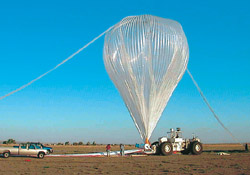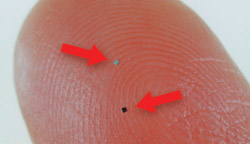 |
|
NIPPONIA No.20 March 15, 2002
|
|

|
Japanese Technology Creates Some of the World's Strongest, Biggest... and Smallest Products
Japanese industrial products are recognized by many as being the most precise in the world, as well as offering the highest quality. There are other superlatives we can use to describe some of them—the biggest, the smallest, the strongest. Here we look at a few of the Japanese high-tech products and technologies that are amazing people around the world.
Written by Matsuoka Hitoshi
Photo credits: NASA; Leiben Industries, Ltd.; Toyobo Co., Ltd.; Hitachi Ltd.; Kawasaki Heavy Industries Ltd.; Reuters Sun; Nippon Steel Corporation; The Yomiuri Shimbun
|

Photo taken during a demonstration test conducted by the U.S. National Aeronautics and Space Administration (NASA). The balloon fabric contains Zylon®.

|
The World's Strongest Fiber
Toyobo Co., Ltd.
Zylon®, the world's strongest fiber, contradicts almost everything we know about fibers and fabrics. Zylon is made by mixing a polymer called PBO (para-phenylene benzobisoxazole), while forcing it through a spinning machine. PBO has a chemical structure that is difficult to process, but a major manufacturer of fibers, Toyobo Co., Ltd., has succeeded in producing this "super fiber." Zylon's tensile strength is about 10 times that of steel—a Zylon thread only 1 mm thick can hold an object weighing 450 kg! Zylon has excellent flame resistance, withstanding temperatures up to 650°C, and is more impact-resistant than even steel or carbon.
Zylon's superlative properties are put to good use in protective clothing like firefighters' uniforms, heat-resistant clothing and bulletproof vests. Zylon is also used as a heat-resistant industrial material, and in the manufacture of optical fiber cables. In 2001, the National Aeronautics and Space Administration (NASA) of the United States used it as a reinforcing material for a space observation balloon.
Saito Masakazu of Toyobo says, "The principles on which Zylon is based were discovered in the United States more than 20 years ago, but it's not easy to make commercial products using it. We were able to do so only after applying Japan's fiber technologies and manufacturing techniques."
|
 |
Mu-chips (IC chips) on a fingertip. The company expects that mu-chips will one day be able to identify products just like barcodes do today. http://global.hitachi.com/ |
The World's Smallest IC Chip
Hitachi, Ltd.
If you think of minute, precision-oriented industrial products, you probably think of Japan. One sector in which Japanese companies enjoy a considerable lead is the miniaturization of semiconductors for tiny integrated circuits. Their newest technologies have been receiving plenty of attention lately.
For example, Hitachi's "mu-chip" is the world's smallest IC (integrated circuit) chip—it measures only 0.4 mm square, and is a miniscule 0.06 mm thick. That's about the same size as a thin slice of a single grain of sand! Even so, the chip contains 128 bits of ID information stored in ROM (Read-Only-Memory), an analog circuit for wireless communications, and a tiny antenna.
When I spoke with Hitachi's PR department, I discovered that the company developed its mu-chip in order to propose a new way to detect counterfeit money. Hitachi made the chips small enough to be embedded in bank notes, and powerful enough to contain data that can be transmitted by wireless technology and recognized by an electronic reader. The chips can be made even smaller if a wireless transmission circuit is not needed.
As soon as the data is read, it is transmitted to a computer that will tell you if a bank note is genuine or fake. No one can rewrite information stored on a chip, and it would be extremely difficult to make counterfeit money or some other fake object, because each tiny chip is embedded inside the real thing.
Technicians in Japan keep making refinements in the areas in which they excel, continually redefining the concept of "miniature." 
|
 |


